放电脉冲重频准分子激光器在不同应用领域的发展现状
2011-05-12LOSEVPANCHENKOYuDUDAREVIVANOVKONOVALOVPAVLINSKYPUCHIKIN
LOSEV V F,PANCHENKO Yu N,DUDAREV V V,IVANOV N G,KONOVALOV I N,PAVLINSKY A V,PUCHIKIN A V
(俄罗斯科学院西伯利亚分院强电流研究所,托木斯克634055)
放电脉冲重频准分子激光器在不同应用领域的发展现状
LOSEV V F,PANCHENKO Yu N,DUDAREV V V,IVANOV N G,KONOVALOV I N,PAVLINSKY A V,PUCHIKIN A V
(俄罗斯科学院西伯利亚分院强电流研究所,托木斯克634055)
研究了脉冲宽度为25~40 ns的放电脉冲XeCl准分子激光器的工作参数。结果显示,激光器产生的脉冲能量为0.2~0.7 J,重复频率为100 Hz,表明在泵浦功率为2.8~3.3 MW/cm3时,激光器实现了2.6%的激光效率和3.8%的本征效率。
准分子激光器;泵浦功率;体放电;预电离;激光效率;脉冲持续时间;气体混合物
1 Introduction
Currently,the excimer lasers are the most powerful and effective sources of coherent radiation in the ultraviolet spectrum.These lasers are widely used in scientific research and technological processes.For the wide application,the lasers should have a sufficiently high efficiency and provide a high energy density and beam power.Simultaneous realization of all these requirements is not a trivial task,especially when it comes to the commercial lasers,which uses a simple double-circuit electrical pump and the frequency mode of operation.The excimer XeCl laser emitting at a wavelength of 308 nm is the second-best one after KrF laser.Typical values of the full efficiency and specific energy generation associated with an active medium for the pulse-periodic XeCl lasers are(1-2)%and 2.5-4 J/L,respectively.These parameters are usually implemented with a specific pump power of 1 MW/cm3and pulse duration[1]of 30-50 ns.At the same time,in some papers[2-4]on the experimental installations,the possibility of obtaining higher values of efficiency and the specific energy generation of XeCl laser was shown.The results of study on XeCl laser with a record-high pump power of 45 MW/cm3and discharge currentdensity of14 kA/cm2were described[5].However,in these conditions the laser efficiency was very low and the power was 0.8%,the maximum specific energy generation was -2.4 J/L·bar,and the intensity of the output beam was-4.8 MW/cm2.By using the ultraviolet preionization of a XeCl laser,the record full efficiency of 2.9%at the intensity of the output beam in-6.5 MW/cm2was achieved[6].However,the specific energy of generation with the active medium was rather low and amounted to 0.6 J/L·bar.High efficiency has been realized with the pumping power density of 3.77 MW/cm3.With the mixture pressure from 4 to 6 bar and the charging voltage from 18 to 36 kV,the laser efficiency decreased to 1.8%,but the specific power output increased by 1 J/L·bar and the intensity of the output radiation was up to 15.7 MW/cm2.In the Ref.[7],we achieved record specific energy generating of~3.9 J/L·bar and high intensity of laser beam of-14.9 MW/ cm2.These options have been implemented in the ignition of the discharge consisting of a set of diffuse channels.The pumping power in the channels at the same time was estimated to be 10 MW/cm3and the discharge current density was-5 kA/cm2.However,the efficiency of the laser with this active medium was low and amounted to~1.2%.
It should be noted that the generation efficiency is significantly reduced with the implementation of the maximum specific energy generation with the active medium in all the above studies.In addition,the experimental results were obtained on mock-ups of lasers operating in a single mode.This condition is certainly easier for the authors of the implementation record of parameters by minimizing the inductance in the pumping discharge circuit.In the commercial pulse-periodic lasers,the discharge circuit pump additionally demands the forced increase of the inductance in the discharge circuit.In view of what was said above,the task of improving the efficiency of pulse-periodic lasers with high laser intensity remains relevant not only from a scientific point of view but also has an important practical significance.
This work is devoted to the study of pulseperiodic XeCl lasers developed in the HCEI SB RAS,Tomsk,Russia in order to determine the optimal pumping for simultaneous realization of a high efficiency generation and high-intensity laser radiation.
2 Experimental setup and measurement technique
Designed lasers operate with a repetition rate from 1 to 100 Hz,producing radiation energy from 0.2 to 0.7 J[8-13]per pulse.Fig.1 shows a photograph of one of the developed EL-500-100 lasers.Control of laser parameters and the change of laser mixture are carried out with the computer.Optimization of the pumping regime in these lasers is performed by changing the parameters of the circuit, profile,length and height of the main electrodes and preionization electrodes,the values of charging voltage,the composition and pressure of a laser mixture.The results of these studies formed the basis of our developments,which is in consequence of the continued search for optimal conditions for efficient generation of pumping lasers.

Fig.1 Front view of EL-500-100 laser.
The double-circuit electrical circuit with an automatic ultraviolet preionization of the gap(see Fig. 2)is used in lasers to create an active medium(the volume discharge ignition).As for different lasers the value of storage capacity C1and discharge capacity C2are varied in the range from 40 to 107 nF and from 22 to 72 nF,accordingly.In EL-200-50 laser the capacity C1consists of KVI-3 and C2-UHV-6A,2 700 pF&30 kV capacitors.TDK capacitors are only used in other lasers.Charge of storage capacitor C1is carried out from small-sized DC voltage to a value of 20-25 kV.After charging of the C1capacitance,the switch is triggered and the discharge capacity C2is pulsed charging.Thyratron TPI1-10k/ 20 is used as a switch.The value of charger circuit inductance of 120-150 nH is able to provide the effective recharging of the first capacity to the second one for quite a long time of~150-180 ns,thus providing a great resource of the thyratron operation. During charging of a C2capacitance,the automatic UV preionization of the laser Discharge Gap(DG) by the Spark Gaps(SG)is realized.After the pulse charging of C2capacitance to a voltage close to U0,the laser gap breaks through and the laser pumping operates.The design of the laser chamber,discharge capacitors and current distributor between capacitors and discharge electrodes are made in such a way as to ensure the minimum value of inductance in the discharge circuit which amounted to 3.5-4 nH. The small magnitude of this inductance provides the greatest rate of a discharge current increase,which is very important for the ignition of a homogeneous volume discharge in the discharge gap.
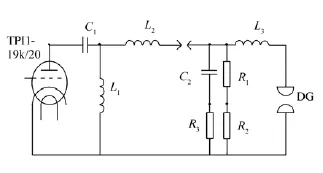
Fig.2 Diagram of excitation circuit.DG:laser discharge gap;SG:spark gaps for preionization;C1:storage capacity;C2:discharge capacity;L1=100 μH;L2=150 nH;L3=4 nH,R3:current shunt;R1,R2:voltage divider.
The discharge chamber of lasers is fabricated from dielectric material(caprolon)and its inner surface is covered with special protective lacquer.Inside the chamber are the main discharge electrodes with a working surface length of 65 cm.The interelectrode distance in the different lasers varied in the range of 22-28 mm.The working electrode surface is a sphere whose radius for different lasers is 3 or 4 cm.The effective width of the discharge varies in the range of 5-10 mm depending on the charging voltage and the composition of the laser mixture. Both sides of the main discharge gap with a step of 17 mm are located the SG for the UV preionization. At the end of the chamber,a plane-parallel resonator is set,whose length is about 100 cm.The cavity mirrors have the reflection coefficients of 0.95 and 0.07.The discharge chamber is hermetically connected to an aluminum cylindrical cell,which houses the blow gas system,cools and cleans the laser mixture.All the metal elements located in the cell and its inner surfaces are covered with a protective layer of Al2O3.The gas flow in the chamber creates a diametrical fan driven by an electric motor through a magnetic clutch.The rate of gas flow is varied depending on the laser operation frequency providing a linear increase in laser radiation power with increasing frequency.The developed blow gas system can provide the flow rate of gas mixture from 5 to 20 m/ s.The gas mixture cooling is carried out by the radiators with the tap water.The electrostatic filter that captures particles that pollute the gas mixture is used as cleaning system.A gas mixture Ne/Xe/HCl/H2at an absolute pressure of 3.6-3.8 bar is used in lasers.Laser mixture is prepared in the laser chamber.Recording of the current-voltage characteristics of the discharge pumping as carried out in experiments using a current shunt to measure the current of one of the discharge capacity,as well as resistive voltage divider(see Fig.2).Temporary form of laser pulse was recorded by photodiode FEK-22SPU.All electrical signals were recorded on Tektronix TDS 3014 and 3032 oscilloscopes.The energy of the output radiation was measured by a Gentec-E power meter.
3 Results and discussion
Before developing these lasers,we have conducted preliminary experimental study to find optimal conditions for the pumping.The results of these studies have shown that for the effective generation of XeCl laser with short pulse duration of~25-40 ns(FWHM)the optimum pump power should be in the region of 2.5-3.5 MW/cm3.In this regard all our research and subsequent development are undertaken in this pump region for different pumping pulse durations(duration of the discharge current at half-amplitude of-23,30,35 and 39 ns)[8-10].To achieve the power density of pumping of 2.5-3.5 MW/ cm3,it is necessary to ensure the discharge current density more than 1 kA/cm2.Ignition of the bulk discharge with high current density imposes a more stringent requirements for the level and uniformity of the gap preionization,the homogeneity of the electric field in the gap and the rate of a volume discharge formation.Our studies were devoted to finding the conditions for implementing these requirements.
Fig.3 shows the typical oscillograms of the laser generation pulse,voltage and current on the discharge capacity C2for the three developed lasers. For the EL-500-100 laser,it also shows the behavior of the specific pump power,the maximum value of which amounted to 3.3 MW/cm3for the volume of active medium in 130 cm3.All figures are for the optimal generation conditions of each laser.Analyzed results of Fig.3 can be noted that the fronts of the discharge currents for all the lasers are very short and they are equal to 15,24 and 26 ns,respectively for different lasers.The most rapid formation of the discharge(15 ns)for the EL-200-50 laser enabled it to form a homogeneous discharge(22 ns at half-maximum discharge current)with no visible spots on the cathode plasma[8].This pumping mode allows substantially to reduce the electrodes erosion and to increase the lifetime of the laser.With increasing of the laser energy and pulse duration to 35 ns at the cathode spot,plasma occurred leads to a deterioration of the homogeneity of the volume discharge combustion.The time delay of a pulse generation from the beginning of the pump pulse is 15,17 and 23 ns,respectively.This time is determined by the growth rate of the pumping power and the time of XeCl molecule formation in the discharge plasma.It is clear that it should strive for a minimum value of delay to achieve the greatest generation efficiency of the laser.
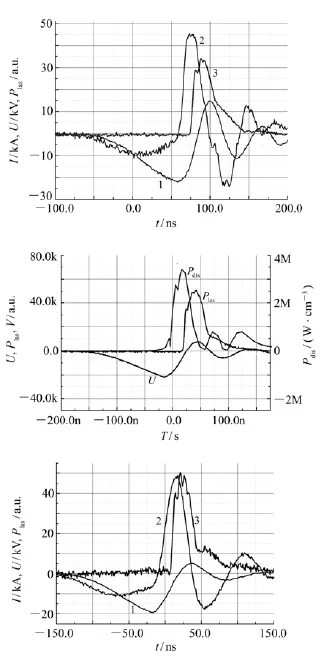
Fig.3 Temporary behavior of voltage(1)and current(2)on the C2capacity,the laser pulse(3)and the specific pump power(Pdis)for EL-200-50(a),EL-350-10(b)and EL-500-100(c)lasers.Laser mixture of Ne/Xe/HCl/H2=1 000/ 15/1/0.5 for EL-200-50 and Ne/Xe/HCl/H2 =800/8/1/0.5 for EL-350-10 and EL-500 100.
In all cases,the laser pulse duration was continued for three half-periods of a discharge current which indicates that the discharge keeps its bulk form during these half-periods of the discharge current.
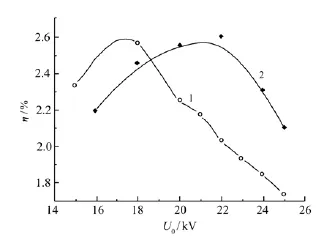
Fig.4 Dependence of the total efficiency for EL-500-100(1)and EL-350-10(2)lasers vs.charging voltage.Mix pressure p=3.8 and 4 bar,respectively.
The focus of research has been directed at improving of the generation efficiency of lasers.Fig.4. shows the experimental dependence of the total laser efficiency vs.the charging voltage U0.Full laser efficiency is defined as the ratio of laser energy to the energy stored in the capacitance C1.It is seen that for EL-200-50 laser the maximum efficiency is 1.8%,while the efficiency of the two other lasers reaches 2.6%.However,if it was achieved at 22 kV for EL-350-10,then this value efficiency realized at 18 kV for the laser EL-500-100.When the charging voltage increased to 25 kV the laser efficiency decreased to 1.7%.In order to determine the cause of the decline in efficiency of the EL-500-100 laser,the effectiveness of the transfer of stored energy from the storage C1to C2and the intrinsic efficiency of the laser generation from the energy deposited into the discharge plasma were analyzed. Figure 5 shows the dependence of these efficiencies(see curves 2 and 1,respectively)vs.charging voltage.Here,comparison to the behavior of the same intrinsic efficiency for EL-350-10 laser(see curve 3)is shown.The dependences 1 and 3 were calculated on a computer with a variable selection of the resistance level that ensures the coincidence of the current-voltage characteristics of the model with experimental results.These data show that the main cause of the total efficiency of the laser is to reduce the efficiency of energy transfer from the storage capacity C1to C2.To increase this efficiency the clearance of the discharge gap was increased from 25 to 28 mm.With a large gap in the charging voltage of 24 kV in a mixture of Ne∶Xe∶HCl=900∶15∶1 at a pressure of 3.7 bar,the energy transfer efficiency from C1to C2increased to 72%(was 55%)and the total efficiency of the laser increased to 2.24%(was 1.85%).These data suggest that to maintain the high generation efficiency,the precise alignment parameters of the discharge circuit,the discharge gap and the value of operating voltage are in the laser requires.In our experiments,the best situation for a set of these criterions was implemented in the EL-350-10 laser.
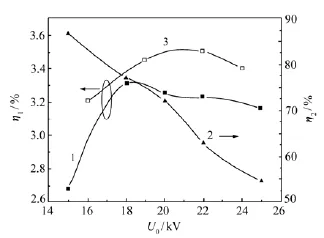
Fig.5 Behavior of intrinsic efficiency of generation for EL-500-100(1)and EL-350-10(3)lasers and efficiency of energy transfer from the storage C1 to discharge C2(2)capacities for the EL-500-100 laser vs.the charging voltage.
Calculation of pumping power for EL-500-100 laser in a range of charging voltage of 18-24 kV shows that its value due to narrowing the discharge width varied only slightly(from 3.3 to 3 MW/cm3). With further decrease in charging voltage to 15 kV,the value of power density was~2 MW/cm3.Fig.6 shows the intrinsic efficiency of generation EL-500-100 and EL-350-10 lasers from the specific pumping power.It is seen that with the decrease of the specific pumping power of less than 2 MW/cm3,the laser efficiency drops sharply.The optimum pumping power is in the range of 2.8-3.3 MW/cm3.The main reason of a generation efficiency decrease in the EL-500-100 laser in comparison with EL-350-10,in our opinion,is related to the deterioration of discharge homogeneity with increasing of pulse duration.Calculation of pumping power for the EL-200-50 laser shows that it does not exceed the level of~3 MW/cm3.Small pumping power at pulse duration of 23 ns does not yield a higher efficiency of the laser.
As already noted,in normal mode,the lasers operate on a mixture of gases at a pressure of 3.6-3.8 bar.But the two lasers were carried out research output generation energy depending on the pressure laser mixture.It is shown that with increasing pressure from 3.6 to 4 bar the generation energy is growing for the laser EL-500-100 and it reaches 615 mJ and the EL-350-10 is-415 mJ.
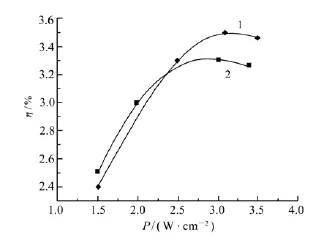
Fig.6 Dependence of the intrinsic efficiency of generation for EL-350-10(1)and EL-500-100(2) lasers vs.specific pump power.
The main parameters for the developed lasers and the maximum values of efficiency and laser energy are listed in Tab.1.

Tab.1 Main parameters for the developed lasers and the maximum values of efficiency and laser energy
In addition some important laser parameters obtained in the experiments should be listed.The specific generation energy of developed lasers is in the range of 4.5-5 J/L.,intrinsic efficiency is 3.3% -3.6%,the efficiency measured by the relative the peaks of laser power and pump power is 3.5%-4%.
4 Conclusions
The paper presents the results of experimental studies of discharge-pulse-periodic XeCl lasers of EL series.The lasers provide the pulse energy from 200 to 700 mJ with 28-35 ns pulse duration and a pulse repetition rate up to 100 Hz.In result,the following conclusions have been made.
(1)Optimum pump power with pulse duration of 20-40 ns is in the range of 2.8-3.3 MW/cm3.
(2)For all developed lasers the volume discharge with a high homogeneity was realized.It provides the generation during the entire pump duration(three half-periods of the discharge current oscillation).Laser pulse duration always has a shift relatively discharge current in the delay time of 15-20 ns.
(3)The record output intensity of 10 MW/cm2for the discharge pulse-periodic XeCl laser was realized.
(4)Total laser efficiency reaches 2.6%,the maximum intrinsic efficiency is~3.8%and efficiency relatively peaks of laser power and pump power is~4%.
(5)Burning of a bulk discharge without visible spots on the cathode is realized in the short pulse duration of~20 ns.This mode allows reduce the erosion of the electrodes and increase the lifetime of the laser(a gas mixture,electrodes,dusting of optical elements).With increasing of pulse duration to 35 ns,while maintaining of the specific pump power in the region of 3 MW/cm3,the brightness and size of visible spots on the cathode increase and it leads to a decrease of the laser lifetime.
[1]BORISOV V M,BRAGIN I E,VINOKHODOV A Yu,et al..Pumping rate of electric-discharge excimer lasers[J].Quantum Electron.,1995,25(6):507.
[2]LACOUR B,BRUNET H,BESAUCELE H,et al..500 watts industrial excimer laser at high repetition rate[J].SPIE,1994,2206:41.
[3]RIVA R,LEGENTIL M,PASQUIERS S,et al..Experimental and theoretical investigations of a XeCl phototriggered laser [J].Phys.D.:Appl.Phys.,1995,28:856.
[4]MAKAROV M,BONNET J,PIGACH D.High efficiency discharge-pumped XeCl laser[J].Appl.Phys.B,1998,66:417.
[5]LO D,XIE J.A megawatt excimer laser of small discharge volume(3.8 cm3)[J].Opt.and Quantum Electronics,1989,21:147.
[6]MIYAZAKI K,TODA Y,HASAMA T,et al..Efficient and compact discharge XeCl laser with automatic UV preionization [J].Rev.Sci.Instrum.,1985,56:201.
[7]PANCHENKO Yu N,IVANOV N G,LOSEV V F.Electric-discharge XeCl laser emitting 10-J,300-ns pulses[J].Rus. Quantum Electron.,2005,35:618.
[8]BYCHKOV Yu I,LOSEV V F,PANCHENKO Yu N,et al..Research of short pulse discharge XeCl laser[J].SPIE,2005,5777:558.
[9]BYCHKOV Yu I,LOSEV V F,PANCHENKO Yu N,et al..Efficiency of discharge XeCl laser with 30 ns pulse duration of radiation[J].SPIE,2006:60530F.
[10]BYCHKOV Yu I,BALBONENKO E F,IVANOV N G,et al..Discharge pulse-repetition XeCl laser with high efficiency and intensity of radiation[J].SPIE,2007,6611:66110E.
[11]PANCHENKO Yu N,LOSEV V F,DUDAREV V V.Generation of diffraction-limited nanosecond and subnanosecond pulses in a XeCl laser[J].Rus.Quantum Electron.,2008,38:369.
[12]PANCHENKO Yu N,LOSEV V F,IVANOV N G,et al..Effective pulse-periodic excimer lasers[J].Atmospheric and Oceanic Opt.,2008,21:674.
[13]DUDAREV V V,KOTOV Yu A,LOSEV V F,et al..Research of production conditions of CeGdO nanopowder with help of excimer laser radiation[J].Proceedings TPU,2008,2:140.
Author′s biography:Valery Losev(1950—),Professor,male,works at High Current Institute of Tomsk Polytechnic University. His main research fields are laser physics,gas discharge,plasma physics,optics,nonlinear optics,excimer lasers,fs-laser systems,high quality laser beams,laser technologies,electron beams,high voltage pulse generators.E-mail:losev@ogl.hcei.tsc.ru
Development of discharge pulse repetition rate excimer lasers for different applications
LOSEV V F,PANCHENKO Yu N,DUDAREV V V,IVANOV N G,KONOVALOV I N,PAVLINSKY A V,PUCHIKIN A V
(Institute of High Current Electronics of Siberian Branch of Russian Academy of Sciences,Tomsk 634055,Russia)
The working parameters of the discharge pulse-periodic XeCl lasers with pulse duration of 25-40 ns are researched.Results demonstrate that the lasers generate the pulses of radiation with energies of 0.2-0.7 J and operate with a repetition rate up to 100 Hz.It is shown that the total laser efficiency of 2.6%and the intrinsic efficiency of 3.8%are realized with the pumping power of 2.8-3.3 MW/cm3.
excimer laser;pumping power;bulk discharge;preionization;laser efficiency;pulse duration;gas mixture
Supported by Russian Foundation for Basic Research Project(No.10-08-90002a)
TN248.2
A
1674-2915(2011)01-0001-08
2010-08-11;
2010-10-13
